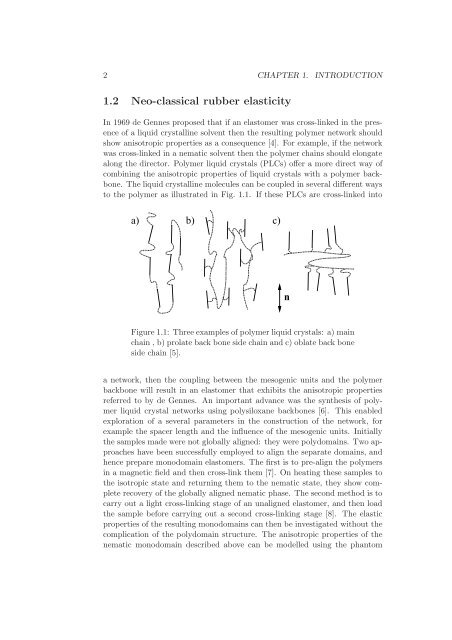Statistical models of elasticity in main chain and smectic liquid ...
Statistical models of elasticity in main chain and smectic liquid ...
Statistical models of elasticity in main chain and smectic liquid ...
You also want an ePaper? Increase the reach of your titles
YUMPU automatically turns print PDFs into web optimized ePapers that Google loves.
2 CHAPTER 1. INTRODUCTION1.2 Neo-classical rubber <strong>elasticity</strong>In 1969 de Gennes proposed that if an elastomer was cross-l<strong>in</strong>ked <strong>in</strong> the presence<strong>of</strong> a <strong>liquid</strong> crystall<strong>in</strong>e solvent then the result<strong>in</strong>g polymer network shouldshow anisotropic properties as a consequence [4]. For example, if the networkwas cross-l<strong>in</strong>ked <strong>in</strong> a nematic solvent then the polymer cha<strong>in</strong>s should elongatealong the director. Polymer <strong>liquid</strong> crystals (PLCs) <strong>of</strong>fer a more direct way <strong>of</strong>comb<strong>in</strong><strong>in</strong>g the anisotropic properties <strong>of</strong> <strong>liquid</strong> crystals with a polymer backbone.The <strong>liquid</strong> crystall<strong>in</strong>e molecules can be coupled <strong>in</strong> several different waysto the polymer as illustrated <strong>in</strong> Fig. 1.1. If these PLCs are cross-l<strong>in</strong>ked <strong>in</strong>toa)b)c)nFigure1.1: Threeexamples <strong>of</strong> polymer<strong>liquid</strong>crystals: a) ma<strong>in</strong>cha<strong>in</strong> , b) prolate back boneside cha<strong>in</strong> <strong>and</strong> c) oblate back boneside cha<strong>in</strong> [5].a network, then the coupl<strong>in</strong>g between the mesogenic units <strong>and</strong> the polymerbackbone will result <strong>in</strong> an elastomer that exhibits the anisotropic propertiesreferred to by de Gennes. An important advance was the synthesis <strong>of</strong> polymer<strong>liquid</strong> crystal networks us<strong>in</strong>g polysiloxane backbones [6]. This enabledexploration <strong>of</strong> a several parameters <strong>in</strong> the construction <strong>of</strong> the network, forexample the spacer length <strong>and</strong> the <strong>in</strong>fluence <strong>of</strong> the mesogenic units. Initiallythe samples made were not globally aligned: they were polydoma<strong>in</strong>s. Two approacheshave been successfully employed to align the separate doma<strong>in</strong>s, <strong>and</strong>hence prepare monodoma<strong>in</strong> elastomers. The first is to pre-align the polymers<strong>in</strong> a magnetic field <strong>and</strong> then cross-l<strong>in</strong>k them [7]. On heat<strong>in</strong>g these samples tothe isotropic state <strong>and</strong> return<strong>in</strong>g them to the nematic state, they show completerecovery <strong>of</strong> the globally aligned nematic phase. The second method is tocarry out a light cross-l<strong>in</strong>k<strong>in</strong>g stage <strong>of</strong> an unaligned elastomer, <strong>and</strong> then loadthe sample before carry<strong>in</strong>g out a second cross-l<strong>in</strong>k<strong>in</strong>g stage [8]. The elasticproperties <strong>of</strong> the result<strong>in</strong>g monodoma<strong>in</strong>s can then be <strong>in</strong>vestigated without thecomplication <strong>of</strong> the polydoma<strong>in</strong> structure. The anisotropic properties <strong>of</strong> thenematic monodoma<strong>in</strong> described above can be modelled us<strong>in</strong>g the phantom
















